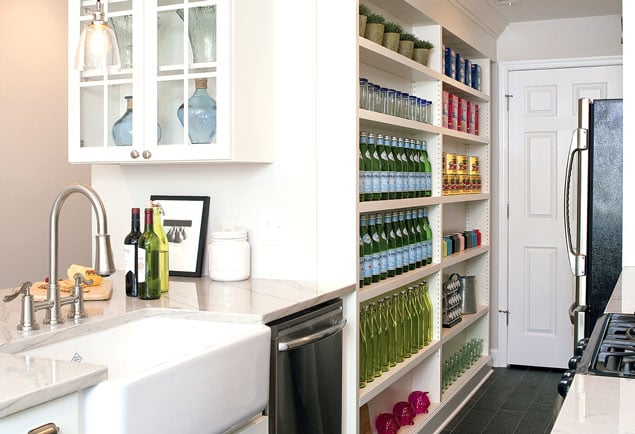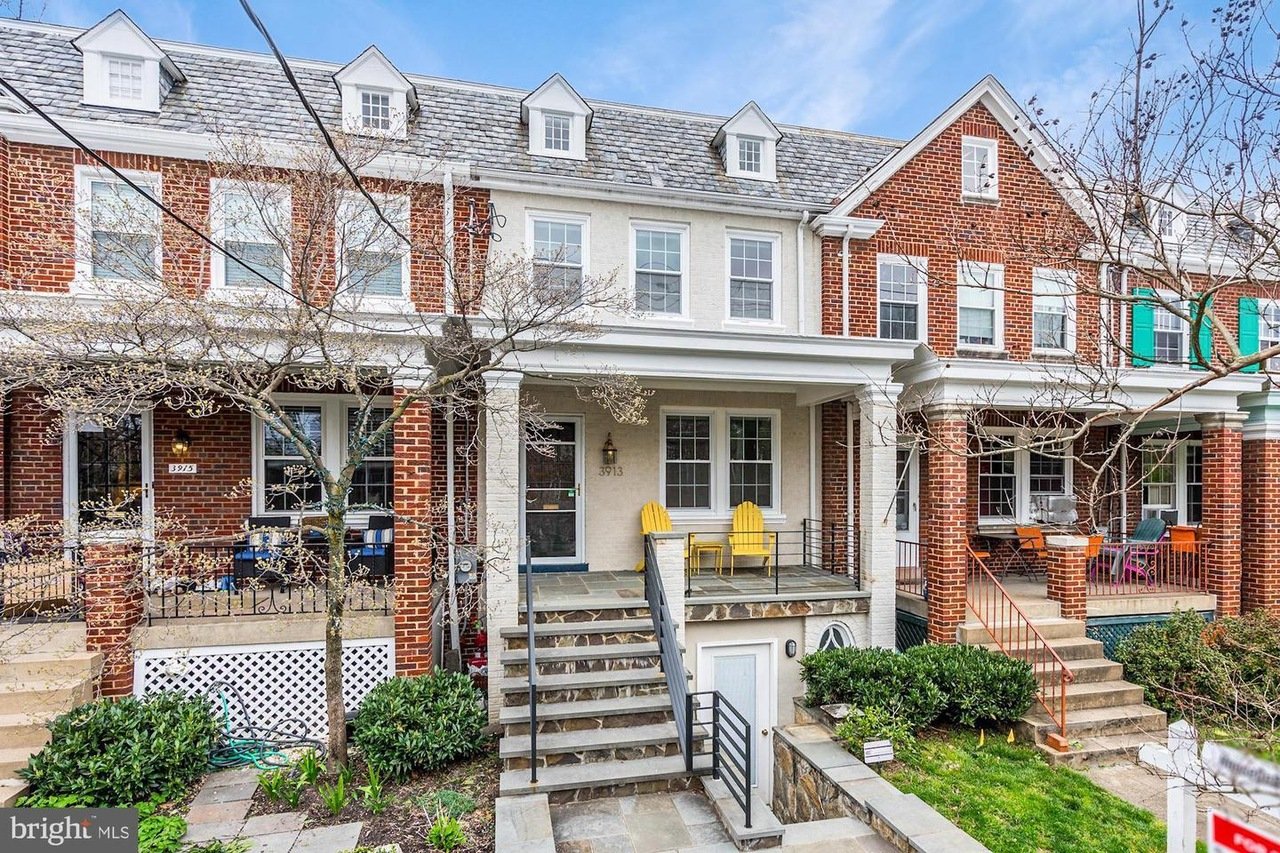Remodeling a kitchen can be expensive. According to the trade publication Remodeling’s 2013 “Cost vs. Value Report,” high-end kitchen overhauls in Washington cost $107,000 on average. Similar projects in smaller homes average about $54,000.
The most expensive item is cabinetry, says Jennifer Gilmer, who owns her own firm in Chevy Chase. She says that in a midrange project—with a budget between about $40,000 and $70,000—cabinets can eat up as much as a third of the cost. Good cabinets are expensive for a few reasons. First, the wood required to make them is pricey—maple and oak are cheapest, walnut costs the most of the common species, and exotic woods such as sycamore can be even more expensive.
Given how much wood is required to fill a kitchen, even “off the rack” cabinets made of the most affordable materials add up. Then there’s the labor that goes into building, finishing, and installing each cabinet.
Designers also point out that the size of a kitchen substantially affects the cost of a project—larger rooms require more materials and more work. But they agree that the look and function of any kitchen can be improved on a relative shoestring. Here’s what you can expect in three budgets.
Basic Remodel $20,000 to $30,000
Bob Kay’s firm, Kitchen & Bath Factory, specializes in small spaces in Montgomery County, Virginia, and DC. He says he can do a full remodel—new cabinets, countertops, floors, lighting, appliances, and labor—for as little as $25,000. But he cautions, “You’re not getting the Mercedes at that price.” One of the easiest ways to save money is to choose stock cabinetry. “The construction doesn’t drive the price as much as the look of the door does,” Kay says. To keep costs down, he tells clients to opt for plain doors in inexpensive materials such as oak and then accessorize. “Think of the cabinets as a black dress and the tile and countertops as the kick-ass things people notice.”
If your cabinets are in good shape, there are ways to freshen them up without dishing out money for a whole new set. You can repaint them and replace the hardware. Or, says designer Lauren Levant Bland of Jennifer Gilmer Kitchen & Bath, replace some cabinets with open shelves—a cost-saver that can also make your space look unique. Another option is to replace only the cabinets from the waist up. Base cabinets are more expensive than their elevated cousins because they’re larger—often 24 inches deep instead of 12—and can have features such as drawers and turntables. What’s more, base cabinets are less noticeable, so you can change the look of the kitchen for a fraction of the price.
Kay also encourages clients to seek appliances by reasonably priced manufacturers such as GE, KitchenAid, and Jenn-Air: “You can get stainless-steel appliances that work just fine for $5,000 to $8,000.” Bland suggests scouring wholesalers for floor models on sale or for “scratch and dent” appliances, which have small imperfections but are otherwise as good as new.
One thing experts agree on: You can do a lot with $20,000 to $30,000, but you have to decide what your priorities are and spend sparingly on the things you’re not likely to notice or use.
Designer Tip
Many people think—and most internet research will tell you—that it’s impossible to change the layout of a kitchen at this budget. Gilmer and Kay say that’s not true. Knocking out a wall—so long as it’s not load-bearing—can be done for less than $3,000 and can open up an otherwise small space. Want to add an island? Taking the top off an antique dining table and replacing it with stone can be an inexpensive way to create an unusual piece.
Mid-to-Upper-Range Remodel $40,000 to $70,000
Customers in this price range often want high-end appliances. Gilmer says this may be because appliance manufacturers have more recognizable names and logos than cabinetmakers do and can give a kitchen a fancier, more name-brand feel without a huge bump in cost.
At this price, your options for cabinets begin to open up as well. Rather than off-the-rack, homeowners in this budget can afford semicustom cabinetry, which allows them to choose from a variety of materials, finishes, shapes, and sizes. Designers say semicustom factories can often accomplish about 80 percent of what customers want at prices significantly less than fully custom cabinets.
When it comes to floors, wood is a good option—it’s nice-looking and less expensive than tile, for which installation can break the bank.
Bland says that one of the most dramatic ways to improve the look of a kitchen, regardless of materials, is with great lighting. She suggests recessed overhead lights, under- and in-cabinet illumination, and decorative fixtures anywhere they’re visible: “Using layers of light controlled with dimmers is the path toward a spectacular-looking space.” Kay also suggests investing in LED lights, which create less heat and last much longer than older technology such as xenon.

Homeowners in this price range can typically afford stone and engineered-stone countertops. But counters can add up, so do your research to make sure you spend smartly. Kay says that the way a piece of stone looks is less a factor in price than how widely available it is. Ubatuba granite, for example, is easily accessed and therefore much less expensive than rarer dark granites that have a similar look and feel.
A distinctive backsplash is a great way to dress a kitchen up. Says Bland: “Metal sheeting is available in plain or pressed patterns and many wonderful finishes that can give you an antique or contemporary look for less than stone or tile. If you’re going for a historical look, beadboard paneling with washable paint is a very low-cost way to dress the backsplashes up.”
Other worthwhile investments: a high-end dishwasher with stainless-steel inside to reduce noise and dual-fuel cooking appliances, which combine gas stovetops and electric ovens.
Designer Tip
Many homeowners think this budget will buy them the kitchen of their dreams—an approach that designers say can get dangerous quickly. Remember that refrigerators hidden behind cabinet doors, commercial-style ranges, fully custom cabinets, and very thick stone countertops are popular and expensive choices that aren’t likely to be affordable in this range.
Luxury Remodel $100,000 and Up
When spending more than $100,000, you can design a knockout space, though you’ll still have to decide where to splurge and where to keep costs down.
Opting for custom cabinetry over very nice semicustom, for example, will increase your cabinet budget by about 30 percent. Custom cabinetmakers are often boutique shops that work on one project at a time. Their work takes longer and costs more because they produce and install exactly what you and your designer want. The advantage is that you’ll get well-made, beautifully finished cabinets in sizes that complement your space and make it all yours.
Many homeowners in this range choose to hide their appliances behind cabinets for a streamlined look. Gilmer says if you’re trying to keep your appliance budget down, you’ll get the biggest bang by hiding just the refrigerator, which is often the largest appliance in the space.
If distinctiveness is important, you may wish to splurge on countertops. Unusual stones such as onyx, marble, and some quartzites can dramatically change the look of a kitchen.
Beyond these basics, experts say that in this price category, it’s all a matter of taste. Some homeowners want to incorporate one-of-a-kind antiques into their kitchens; others will splurge on furniture-grade cabinets, gasp-worthy stone countertops, or handmade marble mosaics. Those who love to cook might opt for professional ranges and other pricey appliances. The most important thing is to be realistic about how you use your space. If you don’t cook much and your kitchen is more a gathering place, there’s no need to spend on the nicest cooktop and range on the market—perhaps use that money for top-of-the-line counters instead.
Insider Tip
It’s not uncommon to think of a major renovation as a long-term investment. Remodeling’s report says that’s only sometimes true. Midrange kitchen remodels, with average prices of $53,950, add an average of $41,806 to the value of a home. But on high-end remodels, the return is smaller: $73,965 on a $107,242 project. That doesn’t mean a high-end renovation isn’t worth the cost, especially if you use and enjoy the space, but homeowners should be aware of the disparity and understand that they may not get their money back when they sell.


















